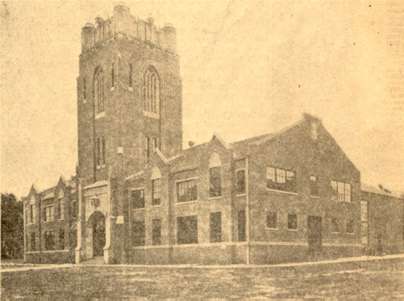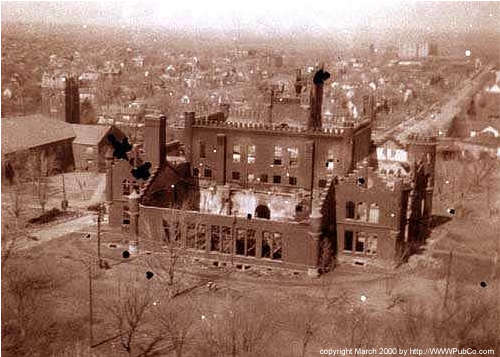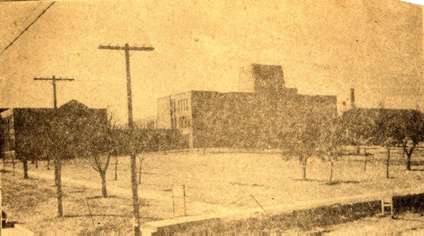|
Moderated by NW Okie! |
Volume 8 , Issue 132006Weekly eZine: (366 subscribers)Subscribe | Unsubscribe Using Desktop... |
Knob Institution Passed 46th Anniversary In March (1943)...
Knob Institution Passed 46th Anniversary In March (1943), 50th Anniversary Edition, dated September 12, 1943, The Alva Review-Courier, Section B.
Opening of the Cherokee Strip in 1893 brought hardy group of pioneers to Alva -- a group who soon conceived the idea of locating a Normal school in the bustling little city and a group that devoted every energy to the fight.
Alva and the surrounding territory developed so rapidly after the opening rush that the pioneers began clamoring for a Normal school and a bill was introduced to the territorial legislature in 1895 for that purpose.
A committee composed of S. L. Johnson, chairman; H. L. Ross, secretary; W. F. Hatfield, editor of the Alva Pioneer; James Kelley, editor of the Alva Republican; C. C. Hudson, editor of the Alva Review; A. H. Andrews, city attorney, and Jesse J. Todd, met and advertised for offers of land near town for a college site. They formulated other plans and applied pressure on the legislature to secure location of school in Alva.
Several responses were made to the advertisement for land, but the most desirable was the hill, one-half mile south of the town, and about two blocks east of where the old Administration building stood.
Their next move was a standing "push" committee to go to the territorial capital at Guthrie and lobby for the school. The committee was instructed to assist Councilman J. P. Gandy and Representative G. W. Vickers. , S. L. Johnson, James Kelley and C. C. Hudson were the first named and others on the committee went to Guthrie occasionally to relieve these for a day or two at a time. They were unsuccessful in this first fight, but they were only temporarily beaten.
On April 1, 1896, a group of businessmen met and formed the Alva Commercial Club. The club gave its attention to general matters until the November election, and then set about getting in touch with the newly elected representatives and councilmen who would make up the legislature to convene January 12, 1897.
S. L. Johnson was again chosen to head the "push" committee and among those who spent more or less time in Guthrie helping in the cause were: Captain Stine, J. D. Share, G. W. Crowell, H. E. Noble, H. A. Noah, J. W. Monfort, Dr. J. D. Karr, C. W. Hobbie, E. Rall, S. B. Share, Jos. Miller, Jesse J. Dunn, H. C. McGrath, F. M. Cowgill and W. C. Douglas.
A record of all the maneuvers in the fight would fill a good sized volume, but the bill passed the council by a vote of eight to five on February 26, 1897. Senators D. P. Marcum of Woodward and William Garrison of Grant county were staunch workers in the cause.
After another bitter fight the bill passed the house of representatives on March 10, 1897. After this those opposed still tried to keep Governor W. C. Renfrow from signing the bill before the close of the session. The men friendly to the bill refused to sign the appropriations bill until the governor signed the college bill. It was either sign the bill or to try to run state affairs without funds for the following year.
The bill was signed about midnight, just before the session closed, March 12.
According to the late Hugh S. Johnson, fiery former head of the NRA, work was actually started on the building and it was in process of construction before the bill passed. So intent and confident were the pioneers that education would reign in northwest Oklahoma.
The contract for a building was to have been let on July 22 but the governor and board of education would not let it go through until they could decide what size building would be necessary.
Therefore the Commercial club offered to furnish a building in which school could start in the fall of 1897 and the Alva Congregational church was rented for $150 and classwork started there.
President James E. Ament came here shortly before school opened and on September 20, with two teachers, Mrs. Sarah Bosworth and Mrs. Mary DeLisle, and fifty right students, Northwestern college started operating. By the first of November the enrollment had grown to a hundred and President Ament and the Commercial club started a campaign to convince the governor and board of education that a large building was needed.
On December 1 the board met again, but again put off the letting of the contract. Then for some unexplained reason, the secretary of the board received hundreds of letters from young people all over Woods and adjoining counties. Bids were finally advertised for and on March 10 the contract was let to John Volk and Company. No appropriations had as yet been made for the building., with all the available funds being $5,000 -- in bonds that were voted by the city in order to get the school building here.
Mr. Volk held a consultation with the Commercial club and a number of citizens in this vicinity. They signed a bond to Mr. Volk for $86,018, the amount of the contract. Four of the original signers of the bond still live in Alva. They are J. W. Monfort, W. F. Hatfield, Anton Shafer and George Crowell.
Dr. Ament widely traveled educator, furnished the inspiration for the building, assisting the architect, Joseph Foucart, a native Frenchman, in drawing up plans for the edifice. Dr. Ament had visited one of the old Norman Castles in France and used the general outline for the college buidling.
The structure, first condemned as a folly because of the appearance was later hailed as a masterpiece of architectural beauty.
Actual work on the building started on April 1, 1896, and from then on the work progressed rapidly. The laying of the cornerstone on July 1st brought a large crowd to Alva, a huge parade was staged and many notable people were here.
The structure was of native red brick. It was Dr. Ament's plan to reproduce the gigantic castle he had seen in France, and the huge three-story building here with its towers, turrets and battlements, was to be only one wing of the structure. Dr. Ament's vision was never realized, although he carried it with him long after he left Alva. He died in New York City, July 21, 1936.
According to initial plans the cost was to have been $86,018, but the building was ultimately completed at a cost of $110,000. The dedication speech was written by one of the greatest and most colorful figures in Oklahoma history -- Temple Houston, son of Texas' Sam Houston.
The magnificient structure, booed by many as the "Prairie Prince's Plight," was hailed by thousands. Alva Adams, Colorado governor, who was attorney for the Santa Fe railroad and for whom the city of Alva was named, arranged for a special train to provide transportation for the territorial legislators to come to Alva for the dedication.
The erection of the building was steady and the college grew with no more interruptions until Governor Ferguson needed president Ament's place for a friend and he was replaced with T. W. Conway, coming here in the summer of 1902.
After Mr. Ament came to Alva, the school and city had no stauncher worker than he, and it was conceded by all that the school had the most rapid growth of any ever opened west of the Mississippi river.
The building served the college students as a hall of learning and a meeting place for many school and social activities for many years. Here were held all gatherings of the towns that were too large for other meeting places. Here were welcomed speakers and entertainers of national repute. And here was gathered an immense crowd to attend burial services for one of the best loved of the college instructors and legislators -- Professor E. A. Herod, for whom Herod hall is named.
Science Hall -- In May, 1905, the demand for another building was so great that the state legislature appropriated $50,000 for a Science building. The action was validated by the federal government in June, 1906, and President Theodore Roosevelt signed the bill a few days later. The Science hall was completed in the fall of 1907 and the rapidly growing college had added another mark in its progression to one of the leading institutions of the state.
That same year, 1907, the central heating plant was completed at a cost of $50,000. No other buldings were added until 1919 when Wyatt gymnasium was constructed.
In 1919 the Normal school was no more -- it became a four-year college with power to confer bachelor degrees. Success of the transfer was greeted with delight by boosters for the college, who then sensed an additional growth.
 Herod Hall -- It was necessary to bring the school up to a par with other state institutions then and in 1923, after several years of effort, the state legislature appropriated $100,000 for building Herod hall and making other improvements. Herod hall was designed after the main building at Oklahoma City University.
Herod Hall -- It was necessary to bring the school up to a par with other state institutions then and in 1923, after several years of effort, the state legislature appropriated $100,000 for building Herod hall and making other improvements. Herod hall was designed after the main building at Oklahoma City University.
The institution, known after 1919 as Northwestern State Teachers' college, prospered until 1935, when the Administration building burned. Herod Hall, in the center of the campus, housed the auditorium and music classrooms in 1943.
 The "old castle on the hill" had woven itself strongly into the hearts of everyone -- it was a landmark, not only to those who had been students in the college, but to every one who had occasion to pass this way.
The "old castle on the hill" had woven itself strongly into the hearts of everyone -- it was a landmark, not only to those who had been students in the college, but to every one who had occasion to pass this way.
It was with grief in their hearts that townspeople watched the building burn March 1, 1935. They realized that it could never be replaced in fact or in sentiment.
Action for a new building was begun immediately, a meeting on March 2, resulting in immediate action in the state legislature.
The two new buildings at Northwestern college, although of entirely different design than the administration building, are regarded as monuments to the fearlessness of those early day pioneers.
Northwestern college today stands as one of the best equipped and most modern of schools in the state and a continued advancement is forecast for the center of northwest Oklahoma activities.
The presidents who have served at Northwestern college (as of september 12, 1943 article):
President Ament from 1897 until 1902, then Thomas W. Conway from 1902 until 1908.
He was succeeded by Walter Ross, who served from 1908 to 1910, when Grant B. Grumbine, superintendent of schools at Geary, came to Northwestern.
Mr. Grumbine ws moved to Central State Teachers' college at Edmond, in 1916, and J. W. Graves had previously been president of the School of Mines at Wilburton and served here one year.
A. S. Faulkner, professor of education at Southeastern Teachers' college, was then sent her.
In 1919, James P. Battenberg, superintendent of schools at Atoka, was elected president here. His was the longest administration in the history of the institution, serving until 1928. He was mainly instrumental in securing the appropriation for Herod hall.
Walter W. Parker, dean of faculty at Warrensburg Teachers' in Missouri, became president in 1928 and served until July 1933, when he became president of the Cape Giradeau Teachers in Missouri.
He was followed by O. E. Hatcher, an instructor in history at Oklahoma A.& M. College. It was during his administration that the building was destroyed by fire.
In May, 1935, President Hatcher was succeeded by Dean Sabin C. Percefull, during whose administration $245,000 was obtained from the federal government to match the $300,000 appropriated by the state to construct Jesse Dunn hall and the new Demonstration building.
In February, 1936, Ernest E. Brown, former president of the Teachers' college at Weatherford, became president.
President Brown was succeeded in 1939 by Dr. C. O. Newlin, former professor of education at the University of Oklahoma. Newlin's resignation on December 31, 1942, brought about the return of Sabin C. Percefull, then president of Northeastern Oklahoma Junior college at Miami, as head of the school he served as professor and dean of many years.
 Jesse Dunn Hall (1943 View) -- Jesse Dunn Hall replaced the "Old Castle on the Hill." after the March, 1935 fire. It has one of the best equipped Physics laboratories in the state. All the recent Northwestern students will remember the many hours spent in NSC's wellstocked library located in Jesse Dunne Hall.
Jesse Dunn Hall (1943 View) -- Jesse Dunn Hall replaced the "Old Castle on the Hill." after the March, 1935 fire. It has one of the best equipped Physics laboratories in the state. All the recent Northwestern students will remember the many hours spent in NSC's wellstocked library located in Jesse Dunne Hall.
| © . Linda Mcgill Wagner - began © 1999 Contact Me | |
